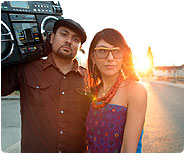|
|
 |
 Dancing Beyond Stereotypes:
Dancing Beyond Stereotypes:
Aboriginal Music Week Bursts with Artists’ Bold New Energy, November 2011 in Winnipeg, Manitoba
The heyday for Aboriginal artists is now. With centuries-old fiddle tunes unreeling beside bumping club beats, with killer flow rocking the mic beside gritty guitar blues, there’s never been more creative space for young people of First Nation/Native American, Inuit, and Métis (mixed European and First Nation) heritage. They can sing their roots, weave newfound urban communities, and dance beyond stereotypes.
Aboriginal Music Week (November 1-6, 2011) in Winnipeg, Manitoba showcases this vibrant new energy, bringing together a broad sweep of North American artists and a growing, youthful urban audience. Concerts get Elders square dancing, kids chanting along with MCs, and dance floors packed with soaring pow wow drum breaks.
“We have found that Aboriginal people want to see Aboriginal artists perform all kinds of music,” explains Alan Greyeyes, festival curator. “We produce the festival for Aboriginal people but we really want to use the festival and the music to build bridges with other communities. And it’s working.”
This year’s headliners show the diversity and range of Aboriginal music: A Tribe Called Red’s hard-hitting, pow wow-powered electro (Electric Pow Wow on November 4); Leela Gilday’s reflective folk; Derek Miller’s rootsy rock (The Saturday Night 49er on November 5); John Arcand’s generations-old, masterful Métis fiddle (Take the Fort! on November 1); Winnipeg’s Most and their fresh, wildly popular hip hop (Hip Hop Night on November 2).
“It’s an exciting time to be Aboriginal in Canada right now,” enthuses Bear Witness of the DJ collective A Tribe Called Red. “The community across Canada is coming together more and more, especially around the arts and music. There’s so much going on, so many interesting things, so many strong artists.”
***
The burst of new creative energy comes after several generations of cultural loss and stigma. “Until quite recently, there were no positive references in media or on stage to Native people, especially in urban centers like Winnipeg,” reflects Greyeyes. “The only time we were in the spotlight was for crimes. But now, kids are seeing Native people are great artists who perform and get played on the radio. They get to see themselves reflected on stage.”
This reflection has many facets. There are raw MCs from rough neighborhoods. There are young musicians picking up the jigs and reels their ancestors used to lure fur traders centuries ago. There is mestizo dub step and good ol’ country and western.
Even within genres, Aboriginal artists tend to bend the rules. Hip hop shows become family events, with preschoolers bopping on stage with their rapping fathers. An edgy club scene inspires artists to return to their roots. Community and tradition breed innovation.
“Our use of pow wow music was about getting this amazing support from the community in Ottawa. The first party we threw was packed with young Aboriginal people we didn’t know. It was a comfortable place for these urban young people to go,” Bear recalls. “We didn’t intend that, but we wanted to give back to them and create music that expressed that connection to the community. Something they could claim as their own.” The result: glittering, striking tracks that seamlessly integrate traditional songs and drums and reclaim pop culture portrayals of “Indians” via wry samples.
“I have found Aboriginal artists to be some of the most boundary-breaking, original, and refreshing artists I have ever met,” notes Gilday, whose carefully crafted songs of Aboriginal life have won her widespread respect in the folk scene. “It is an honour to be a part of a community responsible for this level of creativity, musicianship, and dedication.”
This creativity makes it easy to build bridges to mainstream acclaim. Derek Miller recently recorded a duet with Willie Nelson. A Tribe Called Red caught the ear of golden-boy producer Diplo. Winnipeg’s Most are on heavy rotation at local radio stations and kids of all backgrounds chant their lyrics in the city’s schoolyards. Aboriginal artists tour extensively and win national awards.
Connecting Aboriginal artists—from different scenes, at different points in their career—is part of the broader mission of festival producer Aboriginal Music Manitoba (www.ammb.ca). “We want to create a stronger professional infrastructure for Aboriginal performers,” says Greyeyes. The festival, along with night after night of high-calibre concerts, provides opportunities for artists to network with local community music bookers, and to create moments of contact with new, mostly young audiences.
“For such a long time, our people have been silenced, and we have had to fight to keep our traditions,” says Estella Sanchez, the spitfire mestiza MC of World Hood (November 4). “The fact that Aboriginal Music Week can bring people with similar histories from around the globe together is amazing. We have so much to share as a people, and so much to learn from each other about keeping our cultural traditions intact.”
|
|
 |
|
|
|